- All Posts
- /
- 10 Counterintuitive Lessons We’ve Learned About Email Marketing

10 Counterintuitive Lessons We’ve Learned About Email Marketing
News and Updates-
 Jimmy Daly
Jimmy Daly
-
Updated:Posted:
On this page
There are about six million articles on the Internet that offer email marketing tips. Most aren’t very good. Read a few of them and you’ll come away thinking that a subject line A/B test is the only thing standing between your little startup and an IPO.
We have a different take on email.
We believe email is about trust and two-way communication. Tweet this –>
These ten counterintuitive email marketing lessons sum up nearly everything we believe (and know) about email. If this article makes you feel a little uneasy about your current strategy, good. That’s the idea.
1. Email isn’t about selling.
Do you watch TV for the commercials?
Probably not.
Do you check email for marketing newsletters?
Doubtful.
Email isn’t about selling. The primary reason people use email is to communicate with friends and co-workers. Secondarily, they use it to sign up for apps and services. (All social networks, for example, require an email address to create an account.) Receiving marketing materials is a side effect of using email for other reasons.
Despite all you’ve heard about email as a channel, it’s just a platform for communication. It’s a great place to learn about what your leads and customers want and need but not necessarily the place to close deals.
Think about email as one piece of a multi-channel strategy where trust grows over time. Eventually, there is a tipping point but no single channel gets all the credit.
Aim for less noise:
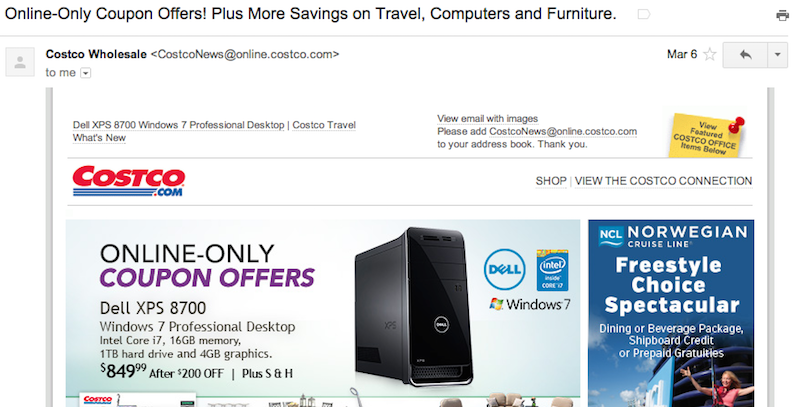
And more signal (h/t Baremetrics):
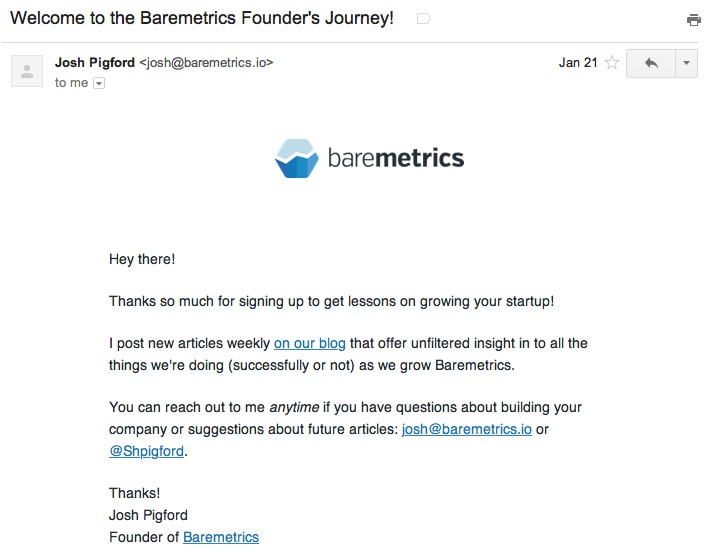
2. Email isn’t that great at driving traffic.
Since January 1, 2015, email has driven 12 percent of the total traffic to the Vero blog. Of that traffic, about 20 percent came from newsletters besides our own.
That accounts for nearly 50,000 visits. That’s great but it’s nothing compared to the 130,000 organic search visits we’ve earned over that same period.
If traffic is your primary goal, SEO has more potential than email. It scales faster and works for you 24/7.
Email does, however, drive targeted traffic. Because subscribers have opted-in to receive your emails, they are predisposed to like you and visit your site.
Our email traffic stays on the site for three minutes and one second on average, 67 percent longer than organic traffic (one minute and 48 seconds).
What can we make of this data? SEO is a better source of new leads and email is better tool for nurturing relationships.
3. Promotional email isn’t a priority.
What’s the first thing that comes to mind when you hear the term email marketing?
Coupons? Sale this weekend? Another newsletter?
Email marketing is many things. Promotional email is just one way it can be used to communicate with customers, subscribers, users and leads.
In our analysis of 100 million emails, we found that transactional emails have a click rate that is 42 percent higher than newsletters. For every 100 clicks you get on a newsletter, you get 142 on a transactional email.
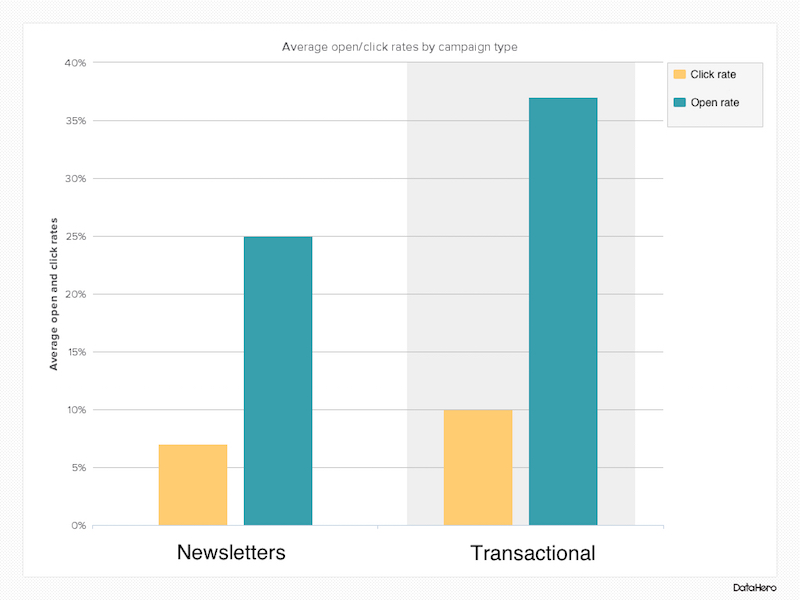
We also talked about the email sweet spot … that perfect place where emails are expected, contextual, personalized and relevant (i.e. lifecycle emails).
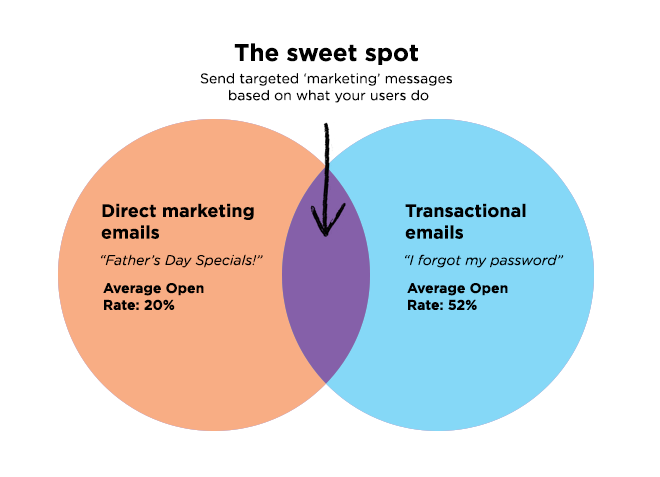
Lifecycle emails should be your first priority. Promotional emails, subject line testing, button color A/B tests … that’s all fine after you’ve laid a foundation of automated lifecycle emails.
If the graph above doesn’t convince you, here’s another way to think about it.
When you create a triggered lifecycle email, it works for you over and over again. Assuming your targeting is right, it arrives at the right time in the customer lifecycle every time.
Compare that to promotional emails, which need to be created over and over again. And even if you segment your lists, it’s nearly impossible to send the right offer to every single person. It’s essentially just guessing.
4. Replies are a huge win.
One conversion metric you might not be measuring is replies.
Here are two important things to think about:
First, people are likely already responding to your emails. If you aren’t checking those responses, track them down. If you send a weekly newsletter to thousands of people, there is intel in those responses that can help you close leads and improve your content.
At Vero, we filter responses to our newsletter through Help Scout so that we can assign the right team member to handle each one. Most responses are “Out of Office” replies but each week, we find a few people who need help getting started with Vero or have ideas for improving the newsletter.

Second, you can simply ask people to reply to your emails. Here’s an example of an email we automate when new users start their first campaign:
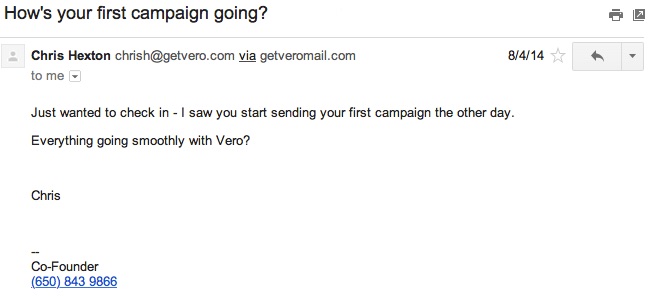
Whatever you do, never send email from an address like “noreply@business.com”. It’s a surefire way to let your subscribers know it’s a one-way conversation.
5. You don’t need to spend a fortune.
We recently published case studies about TripAdvisor and Amazon’s email marketing strategy. As you might imagine, these companies are highly sophisticated and totally automated.
We got a lot of great feedback on those posts but one comment we heard over and over again was, “Those are huge companies with massive marketing budgets. How can I send emails like that?”

Two comments on this point:
First, anyone can send triggered, personalized emails. Software like Vero starts at $99/month and has all the power you need to send emails like TripAdvisor and Amazon.
Check out our features over here.
Second, you don’t build an email program like Amazon’s overnight. It takes time. When people ask us where to start, our answer is always the same – at the beginning.
Onboarding is a great place to kick things off since you can get an ROI so quickly. In order, your first three triggered emails should be:
1. A great welcome email to set the tone

2. A milestone email to reward good behavior
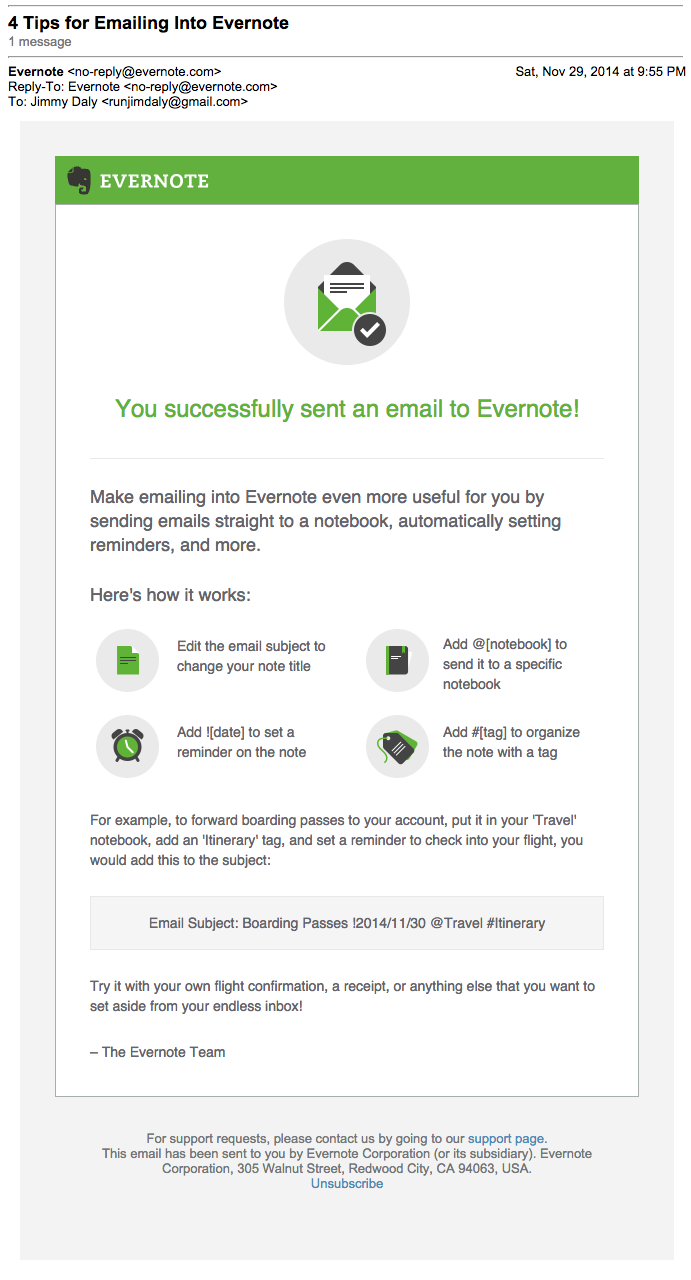
3. A retention email to keep users coming back
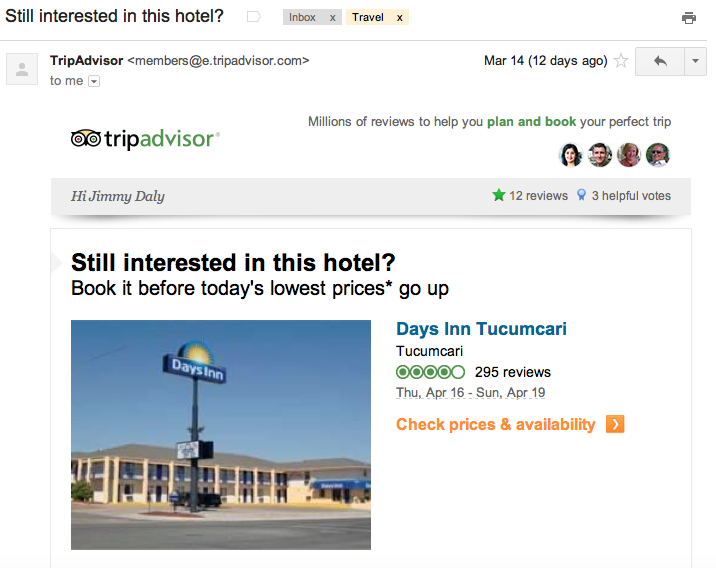
Before you know it, you’ll have an automated email system working 24/7.
6. Subject lines don’t drive opens.
It’s a common myth that the subject line is what gets an email opened.
Sure, it factors in but emails get opened because of the rapport established between the sender and the recipient. Tweet this –>
Take Alexis Madrigal’s newsletter as an example. You won’t find a lot of flash in his subject lines. That’s because it isn’t necessary. People subscribe to and open his newsletter because he sends it. They trust him. Readers like it, so they open the next one.
Trust is scalable. Tweet this –>

Instead of asking, “How can I get more people to open my emails?” ask, “How can I earn more trust?” Tweet this–>
7. Design is less important than you think.
There’s a lot of talk about sending beautiful, mobile-responsive emails. That’s super important if you’re sending HTML emails. Most of our best performing email campaigns are rich text. It’s the perfect middle ground between plain text and HTML.
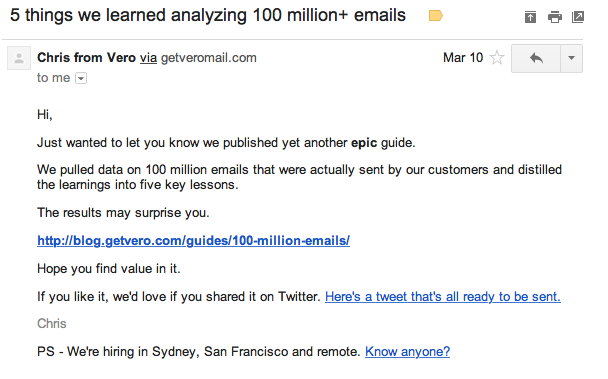
One problem with HTML emails is that there is too much emphasis on design. Rich text emails help you focus on writing for audience of one. Tweet this –> (This is the single most important email copywriting tactic!)
Here’s a quote from our friend Nathan Barry on the topic:
The best way to market online is to teach, to regularly deliver valuable content to your audience so that they will trust you and eventually want to purchase from you. So when you send an email, what part of the communication delivers the most value?
That’s right, the content. So we should be stripping away everything else that isn’t necessary in order to focus on the content. Multi-column layouts, background images, logos, and all the other nonsense that typically fills marketing emails doesn’t deliver value to the recipient. Instead it is all about you, the sender. Flip that around and start delivering value.
Rich text emails can leverage some design, like buttons. A simple email with a bold button is a sweet spot for design. If you are looking for a quick way to increase click-through rates, this is a tactic you should try.
As an added bonus, rich text emails are mobile-friendly by default.

8. Don’t send emails on holidays or weekends.
It’s a good idea to send timely emails but it’s a bad idea to send emails when people don’t want to hear from you.
Think about your favorite holiday, maybe it’s Thanksgiving. It’s a day for family and friends, not email. The truth is that your brand isn’t important enough in your customers’ lives to email them on Thanksgiving.
A note that says “We’re so thankful to have you as a customer” takes away from their holiday. It’s not timely, it’s tacky.
The same goes for weekends. Even though data will tell you open rates are steady over the weekend, have some respect for down time. No one wants your email when they are trying to get away from screens for 48 hours to spend time with their family.
Here’s an example of a timely email. Apple just announced a new MacBook and this email is being sent existing Gazelle customers. The context is built-in.
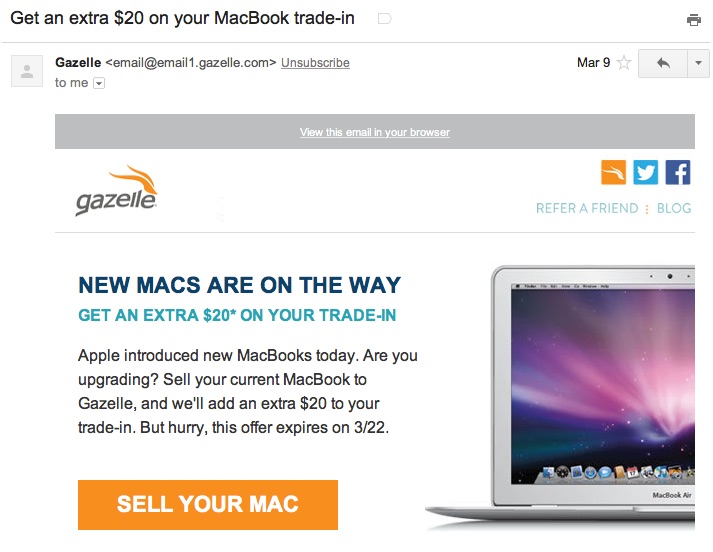
And here’s an example of tacky email. Target is fishing for a few extra dollars at the risk of annoying their customers.

Understand the difference.
Update: I received a “Happy Birthday” email from my student loan lender … the last people I want to hear from on my birthday. This fits perfectly into Bob Hoffman’s brand babble scenario:
Having a successful brand is very important to a marketer. But the idea that it is anything like that to a consumer is folly. Brand babble is just the faulty conflation of marketers’ needs and consumers’ interests.
9. The bigger the list, the worse the emails.
So you have 100,000 people on your list? That’s great, unless you are sending the same email to every single one.
Think about it like this. Each of those 100,000 people has their own budget and their own buying motivations. Each is in a different place in the customer lifecycle. Sending the same message to all of them is a wasted opportunity.
As the size of the list grows, so does the variety of people on it. Eventually, you are just targeting the “average” buyer and leaving out the majority of the people on the list. That’s no way to build trust. You are the noise.
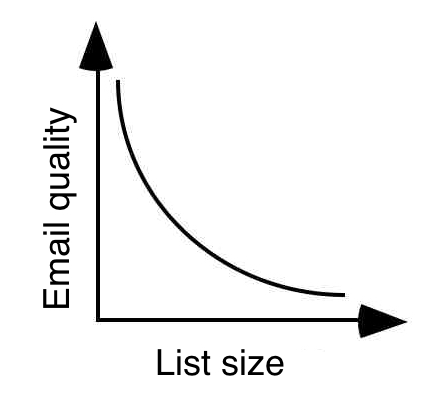
In a perfect world, you would send each of those 100,000 people a unique email. That’s hard to do unless you automate the process.
The best way to avoid sending watered-down emails use external attributes to send super-personalized emails.
See how Vero allows you to do this.
Check out this email from Airbnb. We’ve referred to it as the perfect behavioral email but it’s actually not very hard to send.
Hi {First.name},
[insert data from browsing history]
[insert call to action]
If that’s not the right fit, here are some other options.
[insert other listings in the same area and price range]
Once the framework for an email like this is built, it can be automatically triggered over and over again. On a popular site like Airbnb, 100,000 emails might be triggered in just a few days. And each one is personalized, contextual and highly targeted.
Notice there is little reliance on design, copy or subject lines. It’s all about context.
There is one important caveat to this. If people opt-in to a newsletter and that’s all they receive, you can grow trust and audience simultaneously. Take Moz, for example, who send a bimonthly newsletter called the Moz Top 10.
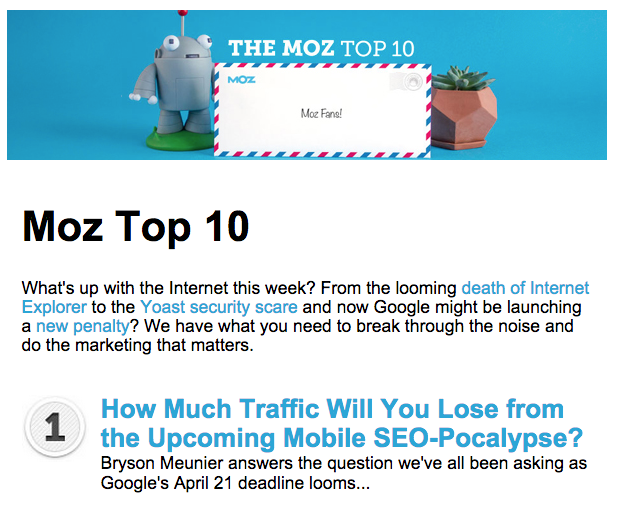
This works because the emphasis is on community and knowledge sharing. Moz is selling trust, not products.
10. You can email people every day …
… if they are expecting it.
Frequency is entirely dependent on the expectation the sender has set with the recipients. Digg, for example, offers an email every day so that’s exactly what they deliver.

To be fair, many companies haven’t set an expectation. So how often should they send emails?
In our massive analysis, we found that e-commerce businesses actually get more clicks on the second email of the week.
We found that e-commerce businesses generally fared better when they sent multiple emails per week. One particularly high lift was the difference between one and two emails a week. On average, e-commerce customers saw an average click rate of 7.8% if they sent one email per week, while those that sent two saw an increase of 27% with an average click rate of 9.94%.
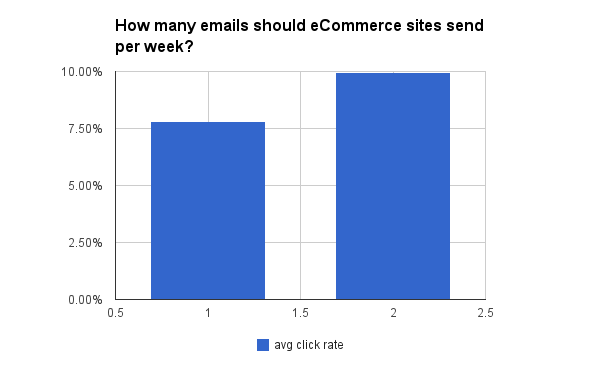
Interesting. But don’t let the data guide you down the wrong path. More is not always better, even if the numbers initially indicate it.
Put yourself in the recipients’ shoes. Do you really want 2-3 emails per week from one company? It’s likely that a temporary increase in frequency will net you more conversions in the short term but it’s a slippery slope.
Be careful not to falsely conclude that more is better. When it comes to frequency, it’s better to earn and maintain trust rather than cannibalize your list.
Were those tips counterintuitive enough? If you have another one, we want to hear it. Drop a note in the comments.

